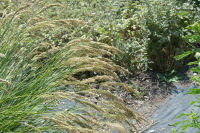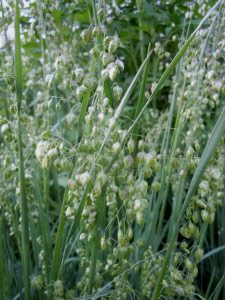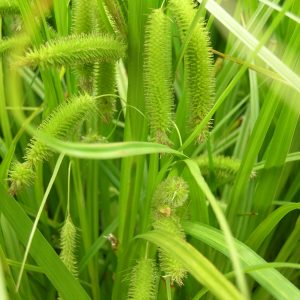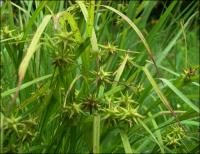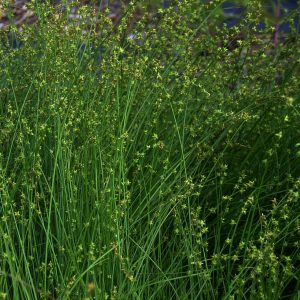Grasses, Sedges & Rushes
Showing 1–8 of 25 results
-
Achnatherum calamagrostis Silver spike grass Z 5-8
graceful, tawny-silvery spikes on this clumping grass
Gorgeous, graceful, tawny-silvery spikes on this clumping grass from June all summer
Size: 36" x 36"
Care: sun in moist well-drained to well-drained soil
Native: Central & southern EuropeCollected before 1750
-
Bouteloua gracilis Blue grama Z 4-9
One sided, horizontal, purple tinged spikelets looking like a row of eyelashes, July-October
One sided, horizontal, purple tinged spikelets looking like a row of eyelashes, July-October.
Size: 2' x 12"
Care: sun in dry to moist well-drained soil
Native: all US except SE & NW, Wisconsin native
Wildlife Value: Host for caterpillars of Green skipper butterfly. Deer resistant
Awards: Great Plants for Great Plains Grass of the Year 2008For the Navajo this was a “life medicine” and an antidote to an overdose of “life medicine.” Also used to cure sore throats and cuts – chew on the root and blow on the cut. Navajo girls carried it in the Squaw Dance. Hopi made baskets from this grass. Zuni made brooms & hairbrushes from it. Several tribes ate this & made bedding for their animals from this. Lakota children played a game using this grass: Most of the stems have two flowers on them. Children competed to see who could find the stems with three flowers, like finding a four-leaf clover. First collected for horticulture by Humboldt & Bonpland who scoured Latin America from 1799-1804.
-
Briza media Quaking grass, Pearl grass, Didder, Totter, Dillies Z 4-8
Elegant inflorescences with dangling oat-like spikelets
Elegant inflorescences with dangling oat-like spikelets in May. Use for cut arrangements, fresh or dried
Size: 30” x 10”
Care: full sun to part shade in any soil. Deer resistant.
Native: Eurasia.In cultivation since at least mid 1700’s.
-
Calamagrostis brachytricha Diamond grass, Feather reed grass
Arching foliage with gorgeous upright plumes
Arching foliage with gorgeous upright pale pink plumes September to November
Size: 4' x 2'
Care: sun to part shade in moist to moist well-drained soil. Deer resistant.
Native: East AsiaCollected before 1856.
-
Calamagrostis x acutiflora”Karl Forester” Feather reed grass
Completely, reliably erect grass - winner perennial plant of year award 2001.
Completely, reliably erect grass.
Size: 3-5' x 2'
Care: sun to part shade in moist to moist well-drained soil. Cut back in late winter.
Awards: Perennial Plant Association Plant of the Year 2001This is a natural cross of Calamagrostis epigeos and Calamagrostis arundinacea, natives of Asia and Europe. German nurseryman Karl Forester’s (1874-1970) keen eye spotted this in the Hamburg Botanic Garden. He listed this in his nursery catalog in 1939. Under Nazi domination he risked it all by keeping Jewish friends & workers. After WW II his nursery was the only perennial supplier in East Germany. This grass sent from Denmark to the US in 1964.
-
Carex comosa Longhair sedge, Bristly sedge Z 4-10
Ornamental dangling bottle brush spikes from May to August
OUT OF STOCK
Ornamental dangling bottle brush spikes from May to August
Size: 2-4’ x 2’
Care: Sun to part shade in wet to moist soil
Native: all of sub-Arctic No. America except western intermountain states and provinces and except Alaska.
Wildlife Value: food for caterpillars of several butterflies. Seeds provide food for wetland birdsRhizomes stabilize shorelines while plants give ducks cover and the seeds provide food. Good rain garden plant.
-
Carex grayi Gray’s Sedge Z 3-8
Cool club-like maces at the ends of stems- June to October
Cool club-like maces at the ends of stems- June to October
Size: 30" x 24"
Care: Full sun to part shade in moist or moist well-drained soil
Native: Vermont west to Wisconsin, south to Georgia and Missouri
Awards: Great Plants for Great Plains1st described in 1835.
-
Carex rosea Rosy sedge, Stellate sedge PERENNIAL GRASS Z 3-9
Mounds of thinnest of medium green leaves mingled with stems with star shaped seed clusters in May-June
OUT OF STOCK
Mounds of thinnest of medium green leaves mingled with stems with star shaped seed clusters in May-June.
Size: 12” x 10”
Care: part shade and shade in moist well-drained soil
Wildlife Value: No. Dakota south to TX & east incl. WI, New Brunswick and Nova Scotia.
Awards: Great Plants for the Great Plains Grass of the Year 2020Collected before 1811.

